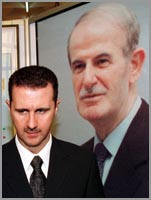The neocons are still beating the drums for U.S. military intervention in Syria, now supposedly for humanitarian reasons. But as horrific as the Syrian violence is it’s clear that President Obama’s restraint last summer averted making the mess even worse, says ex-CIA analyst Paul R. Pillar.
By Paul R. Pillar
Passage of even just a few months adds valuable perspective to debates about prospective uses of military force, debates in which some positions were expressed with passion and conviction. Such has been happening regarding the civil war in Syria.
Not very long ago the United States and some other Western states seemed on the verge of launching their own military strikes in Syria, in addition to providing assistance to opposition elements. Since then all the reasons then already becoming visible why a forceful intervention on the rebel side of this war would be a mistake have become even clearer.
Disarray prevails among the opposition elements that would be helped, with only loose connections between politicians on the outside of Syria and people with guns on the inside. Purported moderates have been weak and ineffective. The strongest opposition groups, in both intra-opposition fighting and combat against the regime, include many extremists having little or nothing in common with any Western objectives.
The latest turn in this story has been a suspension of any U.S. non-lethal aid to the opposition after a coalition of Islamist fighters called the Islamic Front broke into a warehouse and took control of equipment the United States had provided to someone else.
The character of some of the most influential opposition forces has become clear enough for more voices in the West to be saying that the opposition is worse than the Assad regime. Former U.S. ambassador Ryan Crocker says we ought “to start talking to the Assad regime again. … As bad as he is, he is not as bad as the jihadis who would take over in his absence.”
Joshua Landis, director of the Center for Middle East Studies at Oklahoma University, comments that a policy of arming Syrian rebels “blew up in our face,” and that “someone has got to bite the bullet and say Assad stays.” What goes for assisting rebels would go even more for direct external military intervention.
If the Western attack that almost took place earlier this year had in fact been carried out, it would have dragged the United States deeply into a conflict that seems nowhere close to ending. To the extent it would have tipped a balance, it would have done so in favor of a side that, as Crocker notes, is worse than the Syrian regime.
The alternative, the events that have actually played out in the intervening months, is still not pretty to watch, and the politics and diplomacy that led to an attack being called off were essentially an improvised broken play. But the result has been decidedly less bad than immersion in this civil war.
There even has been a positive development on behalf of arms control with the deal regarding destruction of Syria’s chemical weapons.
There still will be those who, out of inertia, cognitive dissonance, or true belief in the unlimited efficacy of U.S. military power, will argue that things would be coming out better if we had only been quicker to act, not only directly but in assisting “moderates” in the opposition.
That position overlooks what it has always overlooked, including the difficulty of distinguishing in this circumstance moderates from extremists, the impossibility of keeping aid only in the hands of the former, and the other realities of the Syrian conflict that have led extremists to gain the prominence they have among the opposition.
Comparing what we know now to what was argued several months ago is useful not only for understanding what is the path of wisdom in dealing with the Syrian problem. It also is useful in evaluating other, possibly broader debates about the use of military force.
Most of our after-the-fact evaluation is based on instances in which we do use force. We can draw lessons, for example, from the Iraq War, and appropriately so, given the huge cost that misguided expedition inflicted on the United States.
But drawing lessons only from such episodes involves a methodological problem that social scientists would call selecting on the dependent variable. Our data base is more complete if we consider lessons from every instance in which use of force became a major issue, whether or not the eventual policy decision was to use it.
Three types of assessment are assisted by such lessons. One is the general question of when military intervention is or is not apt to be advisable. A second concerns the performance of the policymakers. In the case of the Obama administration’s handling of Syria, there was initially a misdirected use of the chemical weapons issue and later reliance on luck and help from the Russians in getting out of a hole, but the final and fundamental decision on the use of force was in the right direction.
A third type of assessment concerns the credibility and wisdom, or lack thereof, of those who engage in these debates. Arguing for what would be a mistaken use of force may not harm the republic if policymakers do not accept the argument, but it still reflects just as badly on those making the argument.
Paul R. Pillar, in his 28 years at the Central Intelligence Agency, rose to be one of the agency’s top analysts. He is now a visiting professor at Georgetown University for security studies. (This article first appeared as a blog post at The National Interest’s Web site. Reprinted with author’s permission.)


It was not the neo-cons that pushed for the Natural Gas war it was the left Obama-Kerry and inc.
I am very proud of my fellow citizens for saying with a loud voice to the powers-that-be “NO more wars for petroleum!”